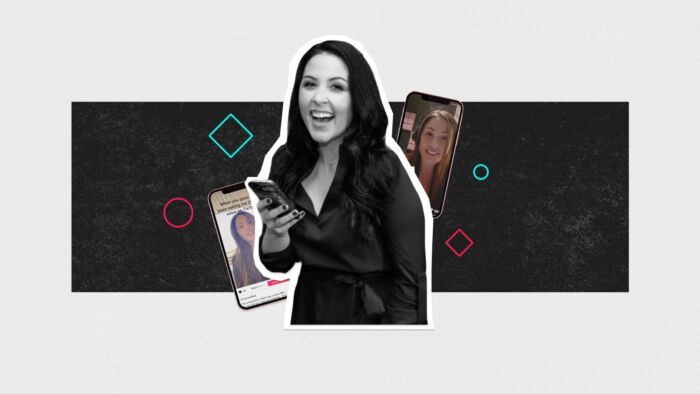What’s green, keen, and completely misunderstood? That would be the Zillennial generation. This “in-between” age group is a demographic of climate advocates, eager spenders, and unrepresented consumers. So who are they, what do they want, and how can you reach them?
We’re digging into the world of Zillennial marketing. This generation is, after all, a seriously powerful one, so you won’t want to miss out on meeting them. It’s about time you had a proper introduction.
Contents
Marketing to Zillennials: An under-utilized market?
The size and spending power of Zillennials
7 Tips for brands wanting to reach Zillennials

What is a Zillennial?
According to Beresford’s research, the millennial generation was born from 1981 to 1996, and Gen Z was born from 1997 to 2012. Zillennials get their name from being in the middle of these generations.
They are the people who fit right into the center of these two demographics that no one (including themselves) really knows about. Zillennials are individuals born between the early 1990s and the early 2000s. Generally, they are between 23 and 33. But there is no strict cut-off point for when someone is or isn’t a “Zillennial”. Ask multiple people, and you’ll get a different answer.
One thing is for sure, though. People who identify as Zillennial understand what it means to be midway between the two generations. They didn’t grow up with a phone in hand quite like Gen Z, but equally did not experience the world quite like millennials did (restricted internet connectivity and fun memories of dial up tones).
So, how did they experience growing up? And how has it formed them as adults?
The Zillennial Years
Gen Z are digital natives. Millennials are digital pioneers. Zillennials are somewhere in between. They grew up with the start of digital technology but weren’t introduced to it from the beginning.
Sabrina Grimaldi, 23, founded Zillennial Zine in 2021, a primarily digital platform aimed at her micro-generation, said: “We’ve been growing up with technology our whole lives, but we’re not TikTok dancers like Gen Z but also weren’t on MySpace like millennials,”
“We are kind of this weird, in-between ground nobody talks about that’s also young and figuring things out, at the beginning of our careers and discovering the world as an adult,” she said. “The most misunderstood thing about us is probably our existence.”
Zillennials identify with both millennial and Gen Z experiences – but they push away from the tropes these generations are labeled with. Many Zillennials may feel as though they don’t fit into either Millennial or Gen Z demographics, even if they do share some of the common values associated with these generations. But what makes them so different from their counterparts, and why should they be categorized as a separate demographic entirely?
What makes this micro-generation unique?
Although Zillennials are 30 million strong, they feel somewhat forgotten. A unique age group who are all grown up, yet still feel like they are learning how to be adults, Zillennials have lived through a lot. They’ve lived through 9/11, a financial crisis a few years later, their professional years, and then all of a sudden, the pandemic. But despite all this, they have built their careers, and income, and are less likely to have dependents.
All of these factors put them in the sweet spot for brands. So why are they still overlooked?
In the coming 10 to 15 years, 80% of Millennials will be parents, so brands looking to target these demographics have been focusing all their attention here. On the other side of things, Gen Z is the youngest generation reaching a massive spending power, and with all their youthful energy and fresh spending habits, marketers have been honing in on how to win them over.
So it’s no wonder that Zillennials feel looked over. We’re here to tell you these individuals are potentially one of the most powerful audiences you can get in front of.

Marketing to Zillennials: An Under-Utilized Market?
As we write this article, the word “Zillennial” is constantly being autocorrected to “Millennial”. It just goes to show how little is known about this generation and how underutilized they actually are.
Deborah Carr, professor of sociology and director of the Center for Innovation in Social Science at Boston University, says even Zillennials aren’t always aware of their own generation.
“I bet most aren’t aware of it,” she says. “ Older Zillennials probably think they’re millennials, and younger ones identify more with Gen Z.”
So why is a generation that’s not even in touch with their own label so important? What can brands learn from them? Although Zillennials may not be calling themselves such, one thing is for certain. They know they are different from their neighbors. They often have certain characteristics they associate with Millennials and Gen Z, but rarely all of the same characteristics.
For brands, too, they have distinct differences you should be aware of, including wicked spending power, more thoughtful buying decisions, and the freedom to spend that their younger counterparts crave.
The size and spending power of Zillennials
There are over 30 million Zillennials existing today, and they have serious spending power.
Over half of them (54%) are employed full time and 12% working part-time. Additionally, Business Insider reports that as many as 48% of adult Zillennials live with their parents. So the combination of income and lack of bills means they have more cash to spend on the things that matter to them.
In addition to this, older Zillennials who are between their late 20s and early 30s come under another group that are big spenders – DINKS (dual income, no kids). Couples living in a DINK household frequently have more disposable income because they do not have the added expenses that come with children. The average age of women giving birth is now 30 in the U.S., the highest on record. And with 46% of 18-29-year-olds in a committed relationship, it just gives you a picture of how many Zillennials fit into this category.
It’s safe to say that this microgeneration really is an untapped market of opportunity. But they aren’t an easy win. In fact, the irony of us even writing this article is that this generation doesn’t want to be “in a box”. It’s quite the opposite.
Brands and Zillennials
One of the defining characteristics of Zillennials and their Gen Z neighbors is that they want to be authentic to themselves.
With this desire in mind, it’s becoming clear that brands need to work harder than ever to show they truly understand these age groups as individuals. That means fewer sales pitches and more genuine connections.
This small generation is notoriously skeptical of brands, with weight being placed on marketers’ shoulders to show up truthfully. Why are they so mistrusting? Because they place a high price on authenticity and value.
They aren’t here just for cheap thrills anymore. Zillennials spend their money thoughtfully, buying from brands that provide genuine value to them. The luxury sector has become more popular among this age group, showing just how much they’re willing to pay for the right brand. Plenty of this generation also turn to refurbished sites for tech and second-hand sites for clothes (like Depop and Vinted). If they can get more value for their buck, they will do it. These value-driven behaviors aren’t, however, just based on products. Zillennials want to see value in the content they consume too.
So it’s up to brands to give it to them.
Zillennials and social media
Zillennials are the most connected generation. In fact, they are more connected than their younger and older siblings. The majority (84%) of this group use social media and their channels of choice are Gen Z’s fave – TikTok, as well as the millennial’s top choice – Instagram. Additionally, you can find them on YouTube and Snapchat. They are users of multiple channels, making an omnichannel approach important for any social media strategy.
They’re a pretty active generation on social. All you have to do is search for “#zillennial” on TikTok, and you get 332M results. Not to mention, each video has thousands of comments talking about the phenomenon, many of which are from Zillennials themselves.
What’s clear is that nostalgia is a big deal for these grown-up kids, and sharing their stories on social media is something they still enjoy doing. So join them in their conversations. Brands can literally become a part of their chats through direct engagement and engaging content. But we’ll delve more into how you can win them over on socials later.
Zillennials shopping habits
We’ve already discussed how Zillennials look for value in brands. But let’s dig a little deeper. These are the top spending habits of Zillennials and what they want you as a brand to do about it.
1. High-end, high expectations
Since Zillennials are the latest to buy into the luxury industry, it’s clear they have a propensity for high-end goods. But with higher prices, Zillennials have higher expectations. Brands need to show up consistently and reward their loyalty to keep them in the fold. This means direct conversations and making products more accessible online.
2. Tech-savvy, experience-keen
Zillennials are 25% more likely to read news through online portals and 10% more likely to play games on consoles like Xbox and PlayStation than Gen Z. They are also 14% more likely than Gen Z to use online casinos and 9% more likely to make retail purchases online for curbside pickup. So what’s this telling us? They are a fundamentally online group. Of course, brands shouldn’t underestimate the power of experience with this demographic either. Their enjoyment of games shows their love for fun interaction, and studies are showing that Gen Z (which they are a part of) are looking for more human experiences.
3. Thoughtful buyers
Zillennials grew up during the economic downturn in 2008 and then proceeded to become working adults during a global pandemic that caused prices to rocket and a huge shift in the employment market. So, can you blame them for being selective in their spending? They are the microgenerations who think twice before pressing the checkout button. So they need to be nurtured in the buyer’s journey, not just sold to.
4. Do-gooders
Zillennials demonstrate a preference for spending on sustainably produced and ethically sourced goods. This feeds into the value-driven element we mentioned earlier, too. The point is this age group are more conscious of what they are buying, where it is sourced and the brands behind it. So it’s more important than ever to be truthful about your offering in every way.

7 Tips for Brands Wanting to Reach Zillennials
If you are looking to win over the Zillennial generation and tap into that spending power, you need to be tactful. With their spending habits in mind, we’ve got a breakdown of everything you need to do to get them listening.
1. Lean into their name, but don’t put them in a box
It sounds ironic since this article is labeled “Zillennial marketing,” but if there is one thing we’ve learned about this age group, it is that they pull away from being labeled. Some may identify as millennials, and some may identify as Gen Z, but because these individuals don’t want to be put into either box, leaning into the word “Zillennial” and all it encompasses may be beneficial. If you think about it, you can make a whole microgeneration be seen just by providing educational content around their demographic. So, speak directly to Zillennials by calling them out. Look for nostalgic content by other creators and see if partnerships could be beneficial.
2. Build Zillennial-friendly communities on socials
Since this age group is the most connected of all, brands have the opportunity to target them on multiple platforms. How do you know where they are? If you create the right kind of content, social media algorithms will help you find them. Now more than ever, younger people are looking for connections on social, not just viral content. So take a multi-channel approach to your social media strategy, create mighty engaging content, and follow up with tons of interaction. It’s imperative that you stay consistent, too.
Go with the aim of building communities, and Zillennials will flock to your accounts. You’ve already seen just how engaged Zillennials can be on socials, so get them involved with your conversations, reply to their comments, and build on their opinions to create meaningful content that lets this forgotten generation feel seen.
3. Be authentic, inclusive, and transparent
Authenticity is a big must for the Zillennial generation. They are also part of the most diverse generation yet, making inclusivity a big deal for brands to nail. But most of all, transparency is key. Zillennials want to know that brands are being real and truthful about their values and, most importantly, where their money is going. If they claim to be sustainable, rest assured, Zillennials will check their credentials. So be real, always, and you’ll have this powerful microgeneration on your side. How can you ensure you’re coming across as authentic? Reach them through the people they trust.
Social media influencers reach 92% of all respondents between 18 and 29 years of age, a direct segment being the Zillennial cohort. Plus, with 61% of consumers trusting product recommendations they get from influencers, it’s a direct way to build on that transparency and gain their trust.
4. Nurture them throughout the funnel
Since Zillennials are thoughtful shoppers, you need to give them the time to, well, think. That means focusing on nurturing them through the buying process. When it comes to socials, brands often jump on top-of-the-funnel brand awareness campaigns and bottom-of-the-funnel sales campaigns. Rarely do we look at the consideration phase. With Zillennials, this is the place to really stick with them.
They will spend more time thinking about a purchase than their younger siblings, and they have more money to spend too. So, really think about their priorities in this phase. How can you remind them of a purchase whilst staying authentic and truthful? The hard sell is unlikely to work, so influencer marketing may be a result-driving option to keep them on the journey.
Once they’ve made the purchase, it’s time to get them on board for the long run. Drum up brand loyalty with a continual presence on socials and stay relevant with the conversations that Zillennials are taking part in. This brings us to our next point…
5. Show you share their values
Understanding Zillennials means understanding their values. We’ve already given you some insights into that here, but to really get to grips with what they love, you need to listen. Participate in social listening with your followers who identify as Zillennials. Spend time in their conversations. Check out their comments. Look at what they’re searching for and what they’re interested in and tap into this for your campaigns.
On a deeper level, take note of the ethical points that matter to them. Make sure you are showing up transparently with your own values and allow your values to align with theirs. And to top it all off, speak those values through like-minded influencers to really get to grips with what matters to them.
6. Lean on your Zillennial employees
Brands struggling to find a tone of voice synonymous with the Zillennial demographic could benefit from looking internally. Talk to your Zillennial employees, find out what kind of marketing activity resonates with them the most, and what they expect from the brands they follow. In our recent “Raised on Social” event, “In the year of effiency, how can brands get more out of influencer marketing?“, we welcomed Future Generation Lab Lead at Samsung, Julia Cohen. She explained how Samsung created the Future Generation Lab as an official “committee” of younger employees. They work with them to test campaign concepts, generate ideas, and sense-check creators. As she explained, it’s amazing how many brands neglect the resource that’s literally already there.
7. Partner with creators that have a Zillennial audience
Partnering with creators presents a valuable solution to a lot of brand specific headaches. In the case of reaching Zillennial target audiences, brands can be thankful for the range of analytical tools available to them across social media. Brands that are looking to reach Zillennials can partner with YouTubers, TikTokers, Instagrammers, and Twitch Streamers whose audience is predominately within the ZIllennial age range. Each platform’s analytics tools enable creators to find out more about their audience, what they like, and their age range, all of which brands can access when partnering with them.
Zillennials are underutilized, so you’re ahead of the game
If you’re still with us at the end of this article, congratulations. You’re a step ahead of most brands. So many companies are looking at Gen Z and Millennials as a whole, and Zillennials is a forgotten microgeneration, full of opportunity. So don’t let them pass you by.
Capture their imagination with authentic digital campaigns across multiple platforms. Lean into influencer partnerships, not just to amplify your message but to validate it. Quality and ethics are non-negotiable; these guys grew up in economic uncertainty and want value for every penny, so make sure you’re delivering on your products too.
Think long-term relationships, not flash-in-the-pan campaigns. Bottom line: Get your brand values in sync, stay transparent, and offer them meaningful experiences.
And if you need help with all of that, we’re here.
We’ve been helping the world’s biggest brands diversify their target audience over the last eight years. Find out more on how we can help you through social first marketing!





